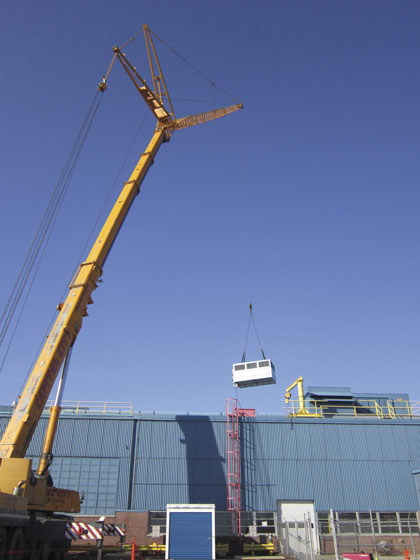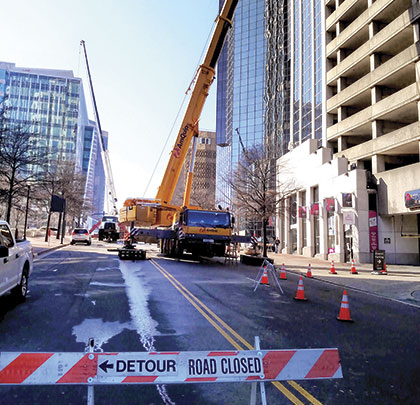Concerning crane suspended loads, OSHA states that the fall zone is considered to be “the area (including, but not limited to, the area directly beneath the load) in which it is reasonably foreseeable that partially or completely suspended materials could fall in the event of an accident.” Although OSHA does not limit the fall zone to the area directly beneath the suspended load, that limited perception is often translated to operators and workers when being trained on safety practices involving suspended loads. Loads suspended by cranes present a high risk to construction workers as 42 percent of all crane-related occupational fatalities have been due to workers being struck by falling objects during a crane’s operation.
FALL ZONE
The fall zone projects out beyond the suspended load just past the area directly below the object. The fall zone of a load, among other items, is affected by the height of the load as well as its size, shape, center of gravity, and connection points. These variables determine the direction and distance the load may swing or fall and roll should an accident occur. It is imperative that the fall zone be accurately identified for crane operators and workers on a construction site.
Employees must clearly know what is meant by “partially or completely suspended materials” when addressing the necessity of safe practices around a load. In review of pertinent regulations and Review Commission judge opinions, once 75 percent of the weight of the load is off the hook, it is no longer mandatory to consider the load suspended, provided that the supporting structure can reliably support the entire weight of the load in the event of crane load failure. However, when 25 percent of the load’s weight is still on the hook and/or the supporting structure under the load cannot bear the entire weight of the load, the load still is considered to be suspended.

COMMUNICATE TO WORKERS
Whether the fall zone is outlined through removable barriers or communicated to workers through diagrams and verbal instructions, workers onsite need to be aware of what area around and below the suspended load is considered to be the fall zone. In addition, workers can use equipment, such as aerial lifts, to stay above a suspended load, as well as outside of the fall zone should it fall. Equipment such as stepladders, mobile platform stairs, scissor lifts, mobile scaffolding, or fixed scaffolding should not be used around suspended loads as they typically place personnel in the fall zone. Employers can also provide their workers with simple tools, such as tag lines, pike poles, boat hooks, or EZ Reachers to allow workers to guide or adjust the final placement of the load from a safe distance.
To simplify control or steady a load being hoisted and to minimize the need for workers to be in the fall zone, workers could eliminate nonessential lifting devices connected to the crane block hook, increase the crane hook size to contain additional nylon slings for stability, shorten the drop hanger sling length from the bottom of the lifting beams, use alignment guides to facilitate self-alignment of the load, and/or use a multiple part crane hoist line to create more precise lifting function, just to name a few options. Additionally, employers could use cranes with “micro-mode” capabilities for both lifting and traveling functions to allow for more precise movement and eliminate the need for personnel to be in the fall zone providing manual or physical control to the load. Lastly, crane operators should consider the use of mobile fixtures, such as mobile transfer tables or mobile work tables, so that the majority of the suspended load’s weight can be transferred to the mobile fixture prior to approaching a fall zone.
Workers should keep in mind that any additional lifting device attached below the crane hook or hook block is still considered to be a suspended load, and poses the same threat to workers below should the crane’s connection fail. With that in mind, any time it is an option to connect the load directly to the hook without the use of additional lifting devices, workers should do so.
GO LOW TO THE GROUND
Whether using lifting devices or not, the load should always be suspended as low as possible to the ground so that the load has less distance to fall, the fall zone is less, and the load has less potential of rolling should the crane’s connection fail. When utilizing a lifting beam or an additional lifting device to assist in suspending a load, the lifting attachment points should be located to the side of the lifting beam or the additional lifting device to decrease the fall zone from the crane hook. The slings should be attached to the load first and then to the lifting device to minimize the size of the fall zone area and to avoid workers being in the fall zone area when connecting to the crane hook.
Since the use of cranes on construction sites is often a vital component of the work being performed, it is imperative that employers and employees understand the risks of harm associated with suspended loads dangers and recognize the breadth of the fall zone should a crane’s connection fail while suspending a load. Employers need to raise awareness of the potential fall zone area around a hoisted load and take necessary steps to ensure the safety of the men and women on the construction site. ■
About the Authors: Michael C. Wright, PE, CSP, CPE, president and Mark E. Williams, director of training, are part of the consulting team for Safety through Engineering, Inc.—a known pioneer in the integration of engineering and safety. STE also provides plaintiff and defense expert witness support for OSHA related issues. Both are actively involved on ANSI and ASTM committees. For more information, visit www.ste4u.com.
_________________________________________________________________________
Modern Contractor Solutions – October 2016
Did you enjoy this article?
Subscribe to the FREE Digital Edition of Modern Contractor Solutions magazine.

Crane “Fall Zones” Are Larger Than They Appear


